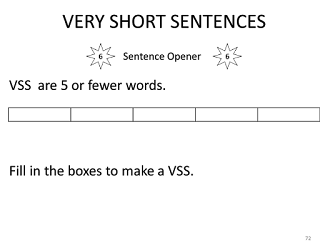Woo Hoo!! Last 6 weeks to go! We've run the race well...now let's finish strong and DO THIS THING!
The kids reached their Chart Challenge goal today by 5 charts! Here's the schedule for all the rewards and festivities:
Week 22: Popcorn buffet during Math, Epic Nerf War from 2:40-3:00. Bring, beg or borrow a nerf gun!
Week 23: Taco bar from 1:00-1:30 on community day. I'll let you know what needs to be supplied.
Remember: Alecia has set a goal of an additional 1,500 charts (2,500 total) by week 24! If the kids can reach that, she will award each kid with a $5 gift card to either Sonic or Chick-fil-A! Keep copying those charts!
EEL:
Structure: Complex
Purpose: Interrogative
Pattern: S-Vt-DO-OCN
We are still working with Complex Structure and added Interrogative purpose today. We began by reviewing what makes a Complex sentence (independent clause with a subordinating Adverbial [www.asia.b] or Adjectival [who/which] clause).
We then reviewed what how to change a Declarative sentence into an Interrogative sentence (1. ? at the end, 2. Interrogative pronoun as the subject, 3. Helping verb at the beginning of the sentence). I posted 3 sentences on large post it notes and the kids worked together to change the sentences from Declarative to Interrogative.
I'm encouraged by how much the kids have learned this year. Knowing this much, their next tour of Essentials will be so much easier!
We reviewed S-Vt-DO-OCN pattern by recalling that there can't be an OCN if there isn't a DO. The OCN compliments the DO.
My sister called the skydiver a lunatic, even though he considered himself a normal guy. (DO OCN)
My sister didn't call the skydiver, neither did she call a lunatic. You must have both for the sentence to make sense. Same with the second clause - you must have a DO in order to have an OCN.
I also reminded the kids that there are certain verbs that give a clue to whether there is an OCN. Consider, call, judge, nominate, etc, are all verbs that indicate there is an OCN. The list is short and can be found in week 16. Go over it with your kids as you're working on OCNs this week.
Speaking of verbs, we visited them again. We talked about Infinitives and Principal Parts. Each kid was given an Infinitive and found the other parts to their verb. I loved making it a challenge and not making the other parts the same color as their infinitive!
When they came back to their table, the arranged their papers in the proper order, then began filling out Chart O with their verb. Have them continue to fill out Chart O with their verb this week! Chart O is actually for the regular verb "to play". Work on that one, too!
HOMEWORK: Continue filling out Chart O, complete more charts and work on your ATS tasks 1-6 on any sentence from weeks 1-19! Start with the earliest ones and work to the more recent ones!
EEL: I listed on the board all the things we've studied since Unit 1. It was an exhaustive list. I asked the kids if I had shown them the list at the beginning of the year, how would they have reacted. There were many forced groans and screams of fear. However, putting it into perspective that we've done ALL those things since week 1, the kids were just as amazed as I was how much we've accomplished. Our kids have worked so hard this year. I know you're proud of them, as am I.
With Unit 8, Formal Essay Models, we are drawing from all the previously studied units to complete our Faces of History paper. Anything that we've used in papers is fair game to use in the FoH! Encourage your kids to look back and decide how many of the decorations, sentence openers, and dress-ups they can add to their paper.
I also explained how we are writing a 5 paragraph paper: Introduction, 1 paragraph per topic, and a Conclusion. This is to make it as simple and achievable for our kids as possible.
There are no new style techniques or dress-ups to be learned for the rest of the semester. I encourage you to have your kids bring their sources to class and we will work through writing a Bibliography together, work on fusing outlines together, and anything else they may need help with. We will use our time wisely while in class to complete as much as we can.
HOMEWORK: Keep working on your FoH papers at home, but bring your sources and we will tackle some things together in class.
PASSWORD: Your Verb Principal Parts! Your kids need to recite for me the Infinitive verb they used in class this week and their principal parts! They took home the slips of paper that their verb was on - easy to recite and remember!
MOMMA PASSWORD: In one of the post it note sentences that the kids turned to Interrogative, what dish does Mom make the worst of? Tell me in private on Week 20 and get a surprise from me! :)
Six more weeks?
Have a great week! See you next Wednesday!
M


































